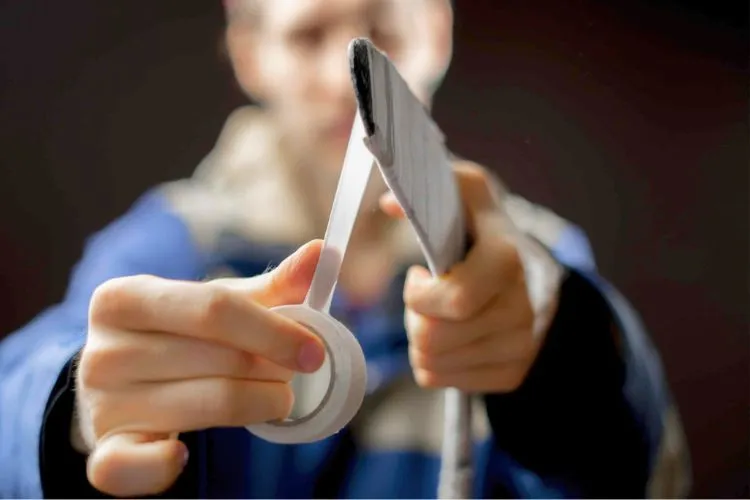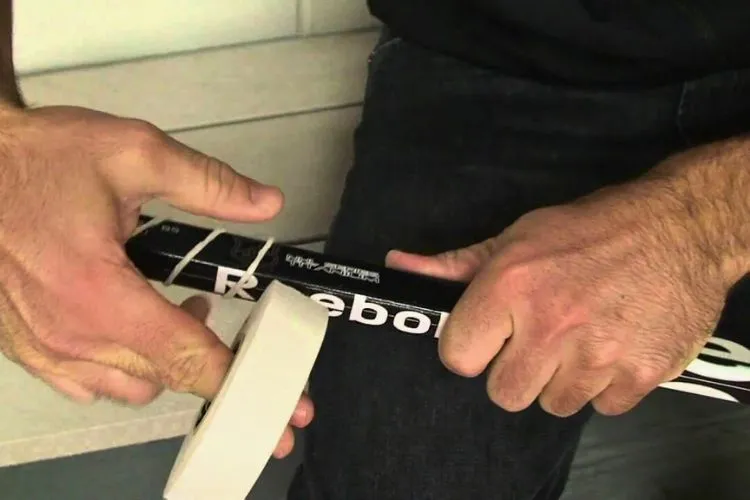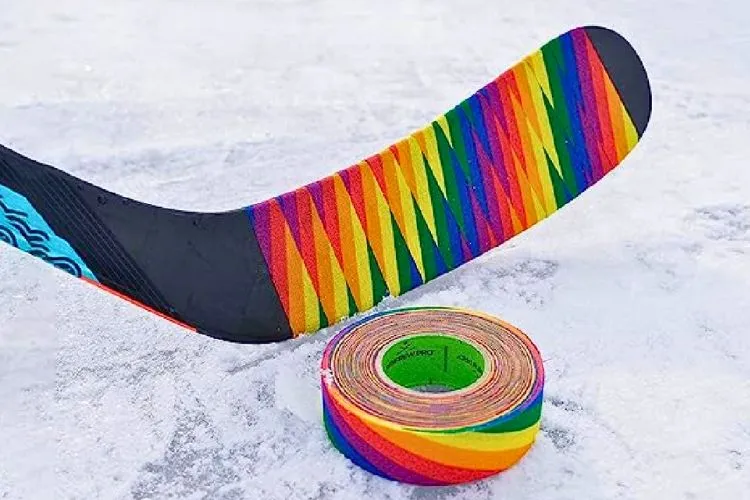Taping a hockey stick is an essential skill for any hockey player. The right tape job can significantly affect your handling, puck control, and even extend the lifespan of your stick.
In this guide, we’ll walk you through how to tape a hockey stick, preparation process, and step-by-step instructions on taping both the blade and handle of your hockey stick.

Essential Materials
Before you begin, ensure you have the right materials. You will need cloth tape specifically designed for hockey sticks. This tape comes in various colors, though black and white are the most common.
You’ll also need a pair of scissors to cut the tape. Some players prefer to add a layer of wax to their blade tape for extra moisture protection, so consider having hockey wax on hand as well.
Preparing the Hockey Stick
Clean the blade and handle of your stick to remove any dirt or old adhesive. If you’re re-taping your stick, carefully remove the old tape. Check your stick for any damage. Addressing repairs before taping ensures you don’t waste materials on a compromised stick.
How to Tape a Hockey Stick?
Starting Off
Decide whether you’ll tape from heel to toe or toe to heel. This decision often comes down to personal preference, but it’s believed that taping from heel to toe can help guide the puck more smoothly.
Method
Begin at your chosen starting point, keeping the tape at a slight angle. Overlap each wrap by about half the width of the tape to ensure the entire blade is covered.
Pull the tape tightly as you go to avoid wrinkles and air bubbles. When you reach the end, cut the tape and press down firmly to secure it.
Finishing Touches
Run your fingers along the tape to smooth out any air bubbles and ensure it adheres well to the blade. Some players choose to trim any excess tape at the toe for a cleaner finish. Lastly, applying a thin layer of wax to the taped blade can help repel moisture and extend the life of your tape job.
Taping the Handle
Grip Taping
For the handle, grip tape, which is usually softer and more padded than blade tape, is ideal. Start by wrapping the tape around the top of the shaft to form a knob. This knob helps prevent your hand from slipping off the stick during play.

Knob Creation
Create a knob by wrapping several layers of tape around the desired area at the end of your stick. The size and shape of the knob are personal preferences, often influenced by your playing style. Some players prefer a larger knob for better grip, while others opt for a minimal approach.
Advanced Techniques
Consider taping the lower shaft of your stick for added grip when handling the puck. Some players apply tape in a spiral pattern, while others prefer a more straightforward wrap. Experiment with different techniques to find what improves your control and comfort the most.
Maintenance and Re-taping
Regularly inspect your tape job for wear and tear. Moisture, friction, and impacts can degrade the tape over time.
Players should re-tape their stick blade as often as necessary to maintain optimal performance. The handle typically requires less frequent re-taping but should be monitored for comfort and safety.
Choosing the Right Tape
In the realm of hockey, the choice of tape can significantly influence a player’s grip and puck control. Tapes come in primarily two types – cloth and synthetic, each offering unique benefits.
Cloth tape is revered for its durability and traditional feel, while synthetic tape boasts superior moisture resistance. The thickness and texture of the tape are also crucial aspects to consider.

Thicker tapes can enhance grip and offer more blade protection, whereas thinner ones might favor players looking for a finer touch.
Color plays a psychological and strategic role; black tape can obscure the puck from goalies’ view, while white tape blends with the ice, potentially deceiving the opposition.
The choice of tape, ultimately, aligns with a player’s personal preference and specific requirements for comfort, control, and performance enhancement.
Pro Tips
Applying a layer of wax to your blade tape can significantly extend its lifespan and improve puck handling by repelling water and ice buildup. For those looking to personalize their stick, consider using colored tape or creating custom patterns.
Though aesthetic modifications won’t impact performance, they can make your stick more identifiable and add a personal touch to your game gear.
You may also find useful: Types of Hockey Helmets: Complete List
Frequently Asked Questions (FAQs)
How often should I replace the tape on my hockey stick?
Replace the tape on your stick blade as often as necessary, usually when it starts showing signs of wear or after a particularly wet game. The handle tape can last longer but should be replaced if it begins to unravel or lose its grip.
Does the color of the tape matter?
While the color of the tape is a personal choice and doesn’t directly impact performance, some players believe darker tape makes it harder for goalies to track the puck.
Why do some players tape the lower part of the stick shaft?
Taping the lower shaft can provide additional grip, which could enhance puck control during quick maneuvers.
Can I use electrical tape instead of cloth tape?
It’s not recommended to use electrical tape as it lacks the grip and durability of hockey-specific cloth tape. Stick to tape designed for hockey for the best results.
How can I make my tape last longer during play?
Applying a layer of wax to your blade tape can help protect it from moisture and wear, extending its lifespan. Additionally, avoiding playing on rough surfaces like concrete can help preserve the tape.
Conclusion
Taping your hockey stick is much more than a routine maintenance task; it’s a personalized touch that can directly influence your gameplay.
By following the steps outlined in this guide, players can ensure their stick is well-prepared for the rigors of the sport. Whether you’re a seasoned player or new to the game, mastering the art of stick taping is essential.
Taping a hockey stick properly can seem daunting at first, but with practice, it becomes a quick and easy part of your pre-game routine.
The right tape job not only protects your stick but can also significantly affect your handling and puck control, giving you an edge on the ice.

Matthew James is a passionate skater who wanted to create a platform to share his love for skating with others. With a vision to create a vibrant community of skaters, he aims to provide a space where skaters of all levels can connect, learn, and grow together.
